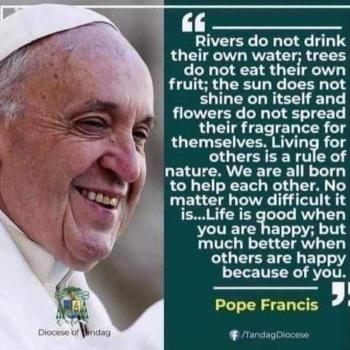Having recently reviewed Father Robert Barron's book Catholicism: A Journey to the Heart of the Faith, and having glanced over different reviews elsewhere, I find myself dwelling on the basic question of how one can describe this faith, this Church, this tradition, this religion, this community, this worldview, this theology. It is an impossible task!
Moreover, in thinking about the Pope's visit to Germany, a country that has lost over 18,000 Catholics this year, and a country whose members call for change in a number of the Church's teachings, I wonder about the ways that my faith embeds itself within changing cultures. An image that comes to mind is of a beautiful building with a foundation deep in the earth, but in an area prone to landslides and earthquakes. To have solid foundations and great beauty is not enough to ensure the building's well being. One must shore up the foundations and monitor the changes in landscape to insure the building's future.
How do we tell the story of Catholicism? The standard narrative (SN), the historical approach, would take a walk through the gospels, into the early Church, the catacombs, the Colosseum, Constantine, the creeds, the monasteries, the texts, the theologians, the reforms, the orders, the missions, into modernity and the Councils Vatican I and II to today. It would focus on the Church's formative role in Western culture; the synthesis of the classical (Greek and Roman) worlds with the world of the Bible; the foundations of Western law, art, ethics, family, and worldview.
The SN has proven an incredible civilization-building approach. Yet today another approach is needed. Why? Because in a storm, the beautiful building is more vulnerable than the blades of grass.
What I mean to suggest is that modernity has seen a series of critiques of the SN and the Church. The Catholic Church is the most centralized global institution in the world: it is easy to attack and critique. Many media outlets delight in targeting the Pope. A host of critical theories have Catholicism in their crosshairs. Those who would decry structures of power are likely thinking about the Church. The Catholic Church is the big bad bogeyman for every conceivable ill in the Western World, because it has had the most formative influence on our civilization.
But Catholicism is not, fundamentally, an ultramontane institution. Its hierarchical structure, its history, its social structures, its money, its patrimony of art and architecture—all these are in service to something much more fundamental. The Church of 2011 has a radical continuity with the stripped-down underground Church of 111: it is all about the love of God. In preaching Christ crucified and risen, it is telling its story of being surprised and delighted that God is real and present. In building cathedrals, painting frescoes, copying manuscripts, erecting dioceses, sending missionaries, composing Glorias, establishing schools, and electing popes, it is drawing together a family of those who have been seized by love for the world through responding to Jesus.
Just over a month ago, I was at a mass with some 1.5 million people. Just a few days ago, in a place where the press reported there being widespread discontent, the Pope held a mass with some 100,000 people present. Why so many blades of grass? Because Catholicism, unlike what many of its critics seem to think, is not fundamentally about a kind of military-like uniformity of taking orders from the general. It is much more like the way that beachgoers watch the ocean: we go because we respond to a summons from the heart. What the SN cannot convey, and what the critics tend to miss, is that Catholicism is fundamentally about a real encounter with the risen Christ, a response to God's own initiative to seduce us into falling in love with him.
Go to China and learn about the Christians—both Protestant and Catholic—who, in spite of difficulty, have grown to numbers larger than those of the practicing Christians of Europe. Go to other parts of Asia where Catholics represent a small minority, or even to the Philippines where they represent a vast majority, and learn about the ways that Asian Catholicism has borrowed from the Western tradition but yet embedded itself in the deep soil of local cultures. Far from being a European monolith, the Church is growing like blades of grass because it nourishes the deepest desires of the heart.
Catholicism, from the Greek word "universal," used as early as the early second century to describe the communion of local churches taking their name from Jesus Christ, began as a movement of people moved by Jesus to form a community. That community grew; it took root in imperial Rome; it built magnificent buildings and developed complex bureaucracies, laws, rituals, and creeds. But at the grass roots, it is about an individual person coming to know another individual person, and repeating what the centurion said at the foot of the cross: surely this is the Son of God.
9/26/2011 4:00:00 AM





